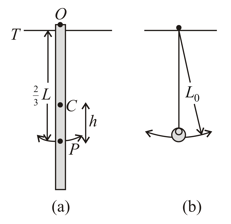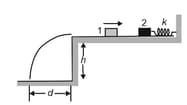We arrange for two blocks to undergo simple harmonic motion along adjacent, parallel paths with amplitude . What is their phase difference if they pass each other in the opposite direction whenever their displacement is ?

Important Questions on Oscillations
An oscillating block-spring system has mechanical energy of , an amplitude of , and a maximum speed of . Find
(a) the spring constant,
(b) the mass of the block and
(c) the frequency of oscillation.
In the figure, a meter stick swings about a pivot point at one end, at distance from the stick’s centre of mass. (a) What is the period of oscillation ? (b) What is the distance between the pivot point of the stick and the centre of oscillation of the stick? (c) If the physical pendulum of the figure and the associated sample problem is inverted and suspended at point , what is its period of oscillation? (d) Is the period now greater than, less than, or equal to its previous value? [Take ]

An automobile can be considered to be mounted on four identical spring as far as vertical oscillation are concerned. The springs of a certain car are adjusted so that the oscillations have a frequency of .
(a) What is the spring constant of each spring if the mass of the car is and the mass is evenly distributed over the spring?
(b) What will be the oscillation frequency if five passenger averaging each ride in the car with an even distribution of mass?
The position function gives the simple harmonic motion of a body. At .
What are the
(a) displacement,
(b) velocity,
(c) acceleration, and
(d) phase of the motion?
Also, what are the
(e) frequency and
(f) period of the motion ?
Two particles oscillate in simple harmonic motion along a common straight-line segment of length . Each particle has a period of , but they differ in phase by .
(a) How far apart are they (in terms of ) , after the lagging particle leaves one end of the path?
(b) Are they then moving in the same direction, towards each other, or away from each other?
A block of mass sliding to the right over a frictionless elevated surface at a speed of . The block undergoes an elastic collision with stationary block , which is attached to a spring of spring constant .(Assume that the spring does not affect the collision.) After the collision, block oscillates in SHM with a period of , and block slides off the opposite end of the elevated surface, landing a distance from the base of that surface after falling height . What is the value of ?

